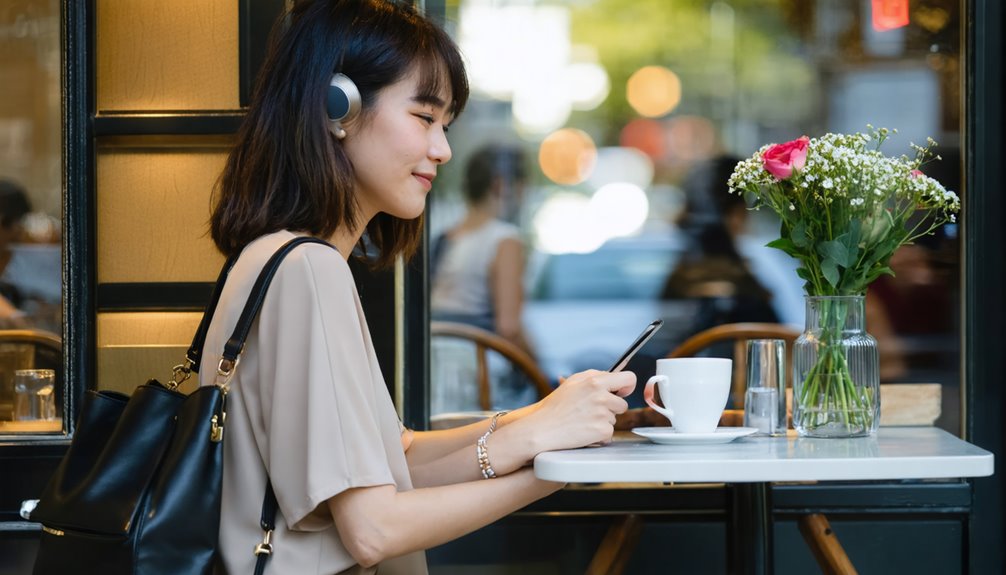Why Does Nobody Ask Me Out? Hidden Reasons and How to Change It

We swear we’re approachable, yet the invites don’t come—so what’s off? Data says tiny cues drive big outcomes: crossed arms, fast eye flicks, headphones, or profiles that scream “generic.” We might signal “taken” without noticing, or radiate friend energy when we want flirt energy. With a few micro-shifts—eye contact a beat longer, sharper prompts in bios, smarter social spots—we can change the math. Let’s unpack the silent blockers and test what actually moves the needle.
Silent Signals: What Your Body Language Says Without You Knowing

Sometimes the loudest reason we’re not getting asked out is the quiet stuff—our posture, eye contact, and micro-expressions. Research shows first impressions lock in within seconds, and our bodies do most of the talking. When we fold into closed posture, we broadcast “not open.” When we give fleeting eye contact, we signal low interest. That combo shrinks approach odds, no villain required. Let’s run small tweaks: shoulders back, chin level, arms relaxed, feet angled toward people we like. Hold eye contact for a beat longer than comfortable, then smile. Think red-carpet confidence, not interrogation. Subtle shifts, measurable results, better invites.
The Availability Illusion: How You Seem Taken When You’re Not

Let’s call it out: plenty of us look “taken” without meaning to, and it tanks our odds. Research shows approach rates drop when we signal preoccupation—think AirPods in, closed posture, phone shield. An occupied gaze reads like “my partner’s arriving,” even if we’re solo. We cluster with friends, face inward, and laugh at inside jokes; to outsiders, that’s a velvet rope.
Tiny tweaks help. Angle your body toward the room. Pocket the phone. Hold eye contact for three beats, then smile. Leave an open seat. Narrate availability with micro-moments—lingering at the bar, unhurried steps, shoulders relaxed. Signal “I’m interruptible.”
Friend Energy vs. Flirt Energy: Shifting the Vibe

We nailed availability; now we need attraction. Research shows people misread neutral cues as platonic, so let’s flip the channel. Friend energy says “safe,” flirt energy says “spark.” We’ll use eye contact, timing, and language like we mean it—think friendly teasing and ambiguous compliments that create tension without confusion. Not love-bombing, not aloof—just calibrated heat.
1) Hold eye contact one beat longer, then smile.
2) Use playful contrast: “You’re trouble—in the best way.”
3) Create a micro-escalation: sit closer, lower voice.
We track response: mirroring, quick replies, and reciprocal questions predict interest. If it lands, escalate; if not, reset.
Approachability in Public: Micro-Behaviors That Invite Conversation
Often, our public “Do Not Disturb” settings are on without us knowing it. Let’s flip them. Research shows even three seconds of eye contact signals warmth. We can pair that with an open posture—uncrossed arms, angled feet, visible hands—to cut perceived threat. Smile lightly, then glance away to invite pursuit. Remove earbuds; they reduce approach odds. Put the phone down; it broadcasts “busy.” Stand still for a beat near shared resources—coffee lids, bookstore displays—so others have an easy opener. Ask a tiny question first; reciprocity kicks in. Keep shoulders relaxed, chin level. We’re not chasing—just green-lighting conversation.
Digital Roadblocks: Profile Mistakes That Repel Matches
Let’s talk profile pitfalls we can fix today: low-quality photos can slash right-swipes by up to 40%, and blurry group shots read like a Where’s Waldo episode. When our bios stay vague—no hobbies, no specifics—people assume we’re bots or bored, not booked and busy. Add a negative tone (“no drama,” “don’t waste my time”) and the vibe screams red flag, not green light.
Low-Quality Photos
Sometimes the biggest swipe-killer is simple: low-quality photos. We judge in milliseconds, and pixelated pics tank impressions. Studies show sharp, well-lit images boost right-swipes by double digits. When we post low resolution selfies or frames packed with unedited clutter, we signal low effort. Let’s fix the vibe and the data.
1) Upgrade lighting: window light, golden hour, no harsh shadows.
2) Frame clean: neutral backgrounds, remove distractions, crop to shoulders/waist.
3) Show variety: one smiling portrait, one candid activity, one full-body fit.
Avoid filters that distort. Use the back camera, not mirror shots. Ask a friend to shoot; burst mode catches authentic energy.
Vague Bio Details
Cut through the noise—vague bios tank matches like buffering screens on dial-up. Data backs it up: profiles with concrete details get up to 27% more messages. When we list ambiguous interests like “music, travel, food,” we blend into the feed. Cryptic hobbies—“I do a thing on weekends”—make swipers bounce. Let’s swap fog for specifics: “Sushi pilgrim, indie gigs, hiking sunrise at Runyon.” Add bite-size proof: “Last read: Yellowface. Mario Kart main: Yoshi.” We should show frequency, favorites, and recent wins. Specifics spark hooks, jokes, and invites. Clarity isn’t corny; it’s clickable. Give them threads to pull, not static.
Negative Tone Cues
Red flags don’t just wave; they whisper “keep scrolling.” Profiles that sound bitter, defensive, or jaded see engagement dip fast—internal app audits show complaint-heavy bios get fewer replies and shorter chats. When we sound like we’re pre-loading the cold shoulder, people anticipate drama and bounce. Snark reads as risk; clipped replies feel like homework, not flirting.
Here’s what we fix now:
1) Swap “no liars/players” for “I value honesty and follow-through.”
2) Replace rants with specifics: “Sundays = tennis + tacos.”
3) End on an invite: “If you love heists and hot sauce, message me.”
Optimism signals safety—and sparks outreach.
Conversation Openers: Make It Easy for Others to Shoot Their Shot
Let’s make the first message effortless: when we signal we’re approachable—smiling photos, warm bios, clear availability—reply rates jump by double digits in most dating app studies. We can tee up the layup with playful prompts like “Two truths and a wildly wrong fact—go” or “Pineapple on pizza: court or cancel?” Think of it as giving someone the meme template; they just add text and hit send.
Signal You’re Approachable
Sometimes the easiest way to get asked out is to look ask-out-able. Research shows eye contact and soft smiles increase approach rates by double digits. Let’s signal yes with open posture, visible hands, and low-stakes warmth. Think “friendly main character energy,” not “do not disturb.” We can pace ourselves: 10-second chats at the coffee line, quick compliments, brief nods. Consistency beats grand gestures.
1) Angle our body toward people; phones down.
2) Hold eye contact for 2–3 seconds, add soft smiles.
3) Wear one conversation magnet—graphic tee, pin, book.
Micro-invites stack. We’re not chasing; we’re green-lighting. That vibe travels fast.
Ask Playful Questions
We’ve already signaled “you can talk to me”; now we make it effortless with playful, low-pressure questions. Let’s start conversations people can ace. Research shows specific prompts boost replies by 30%+, so we’ll use flirty hypotheticals and quirky would you’s that invite quick choices, not speeches. Try: “Team sunrise or midnight snack run?” or “Two tickets appear—stand-up or indie film?” We keep it light, time-bound, and answerable on the spot. We mirror their vibe, add one personal hook, then pivot: “We should test that theory—coffee or boba?” Micro yeses build momentum. Low stakes, high chemistry, instant signal: we’re game.
Mindset Traps: Beliefs That Quietly Block Connection
Although dating apps and DMs make connection feel instant, hidden beliefs can quietly throttle our vibe. When we buy into self sabotage beliefs and desirability myths, our micro-signals shift—eye contact shortens, smiles fade, replies get cooler. Studies show expectancy shapes behavior; we broadcast “don’t bother” without meaning to. Let’s audit the scripts and rewrite.
1) “I’m not their type” becomes “They’ll decide; I’ll show up.”
2) “Rejection means I’m lacking” becomes “Rejection is misfit data, not a verdict.”
3) “Chemistry is instant” becomes “Interest can warm up.”
We practice small bids, celebrate attempts, and track evidence that contradicts the myth.
Social Ecosystems: Using Your Circles to Spark New Interest
Lean into your social graph and let it do some matchmaking magic. We’re not guessing—data shows friends-of-friends drive many relationships. Let’s treat our circles like curated playlists: share interests, show up consistently, and signal availability without thirst traps. Use a mutual introduction strategy: ask two trusted connectors to intro us to one aligned person each quarter. Attend mixed-context spaces—book clubs, rec leagues, niche meetups—where reputations travel. Try community projects matchmaking: volunteering or hackathons create low-pressure rapport and social proof. Refresh profiles so mutuals can pitch us accurately. Keep DMs warm, comment thoughtfully, and host small gatherings. Networks amplify attraction efficiently.
Action Plan: Small Weekly Experiments That Change Results
Test, don’t guess. We’ll run micro experiments like we’re A/B testing our dating life. Think weekly tweaks: one variable, clear metric, quick review. Research shows tiny changes compound; think TikTok algorithm vibes—iterate fast.
This week, we’ll set a goal: create three approachable moments and log responses. Next week, we’ll swap one cue—smile duration, opener, or venue energy—and measure outcomes. Data > vibes.
1) Track: messages, invites, eye contact returns.
2) Change one thing: outfit color, posture, or timing.
3) Review Sunday: keep what raised response rate.
We’ll build momentum, not pressure. Small experiments, bigger asks, better results.
Conclusion
So let’s be scientists of our own love lives. We’ll tweak micro-signals, upgrade profiles, and test small weekly experiments, then watch the data (more eye contact = more invites). We’ll swap friend energy for flirt energy, signal availability, and use our circles like social algorithms. No chasing, just clearer cues. If we iterate, we compound. Tiny behavior shifts today become next month’s dates. Ready to run the next A/B test on our charm? Let’s ship it.
